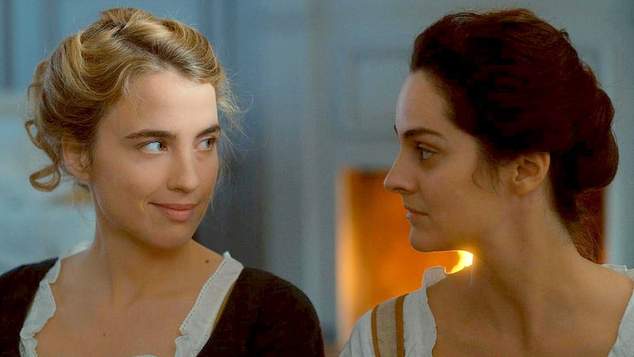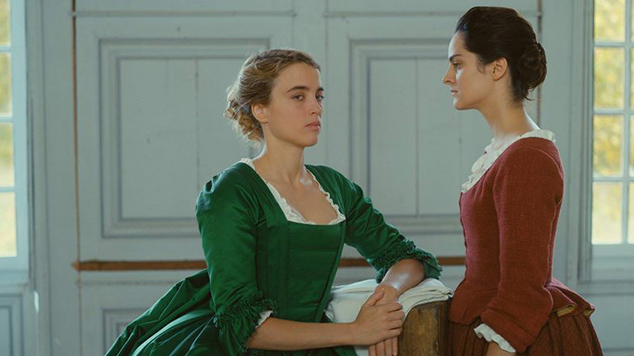
French screenwriter and director Céline Sciamma’s body of work focuses on people as they become aware of their sexuality, those moments when sexuality and identity are formed and break free.
Her previous work as a director includes the film Waterlilies, Tomboy and Girlhood, a trilogy of films about women as they come of age. She also wrote the screenplay to André Téchiné’s 2016 film Being 17, which focuses on two young men exploring their sexuality.
With her fourth film, Portrait of a Lady on Fire, Sciamma stays in familiar thematic territory but takes on the challenges of filming a period drama. The film, which is screening now as part of the Perth Festival, and will later open at Luna, has been receiving high praise.
At the end of the 18th century Marianne (Noémie Merlant) is a painter working from one commission to the next. While male painters can easily command large figures for a commission, women in the industry find it more difficult to make a living.
As she explains at one point, women are considered not to be qualified enough to paint men, as they are banned from study the nude male form in their training. Instead they must make do with what work is left over, and are almost always painting other women.
She is hired to paint a portrait of a young women, Héloïse (Adèle Haenel), whose lives with her mother on a remote island in Brittany. Following the death of her older sister, Héloïse has been betrothed to marry her dead siblings finance who lives in Milan. The wedding will only go ahead if he likes the look of his replacement bride, hence the sudden need for a portrait to be painted.
Marianne arrives at the remote estate, which is on an island where no men live, and is greeted by the lone servant Sophie (Luàna Bajrami). The next day she meets Héloïse’s aristocratic mother The Countess (Valeria Golino) who explains that she is not the first painter to be brought in to create a portrait of her daughter.
As Héloïse had a falling out with the previous artist and destroyed their portrait, Marianne is asked to paint her subject in secret, posing just as a woman to the house as a companion for the lonely young woman.
She must study Héloïse closely, and commit to memory every detail of her face, and then secretly paint her late portrait at night after she has retired for the evening.
When the Countess is called away to the mainland, the three young women are left alone in the house. Quickly the conventions of mistresses and servants are abandoned and the three women treat each other as equals and begin to gain a greater understanding of the restrictions each of them face in their lives because of their gender. Slowly a relationship develops between Héloïse and Marianne, one that they know has no long term viability.
The film won the Queer Palm at the Cannes Film Festival and was also awarded Best Screenplay, and it’s been talked up as a possible Oscar contender in 2020.
OUTinPerth spoke to writer and director Céline Sciamma from her home in Paris. Sciamma said the film’s origin was a burning desire to write a love story.
“The first thought was about writing a love story, and dedicating a film to a love story and how love is born, all the desires and the love that is lived, but it’s also about the memory of a love and what is left of a love story. It’s a film dedicated to love and a love of cinema.” Sciamma said.
Unlike her previous works, writing Portrait of a Lady on Fire gave a different challenge when it came to writing the script, and it wasn’t just the challenge of setting a story in another time period.
“It was definitely a new challenge because you want to document is right, but I also wanted a challenge of new ideas. We had to think about how we recreate the past, often with contemporary objects. There’s two dynamics.”
‘As you research and find new material, it also gives you new ideas. That’s really interesting, but it took a long time, and that’s probably what makes it most different from my previous films. The time it took in research, writing, brainstorming – that was the hardest.”
Casting the film was a fairly straightforward process, Sciamma created the script with the idea that her real life partner Adèle Haenel would play the subject of the titular portrait. When it came to finding the actor to play the portrait artist Sciamma said she was looking for the right chemistry.
“The film was written with Adele in mind, so the main thing in find the other lead was to create this couple, which is something I cannot do. I was looking at first for a physical contrast, I really wanted the blonde and brunette, but I was looking for an actress who wasn’t identified by a wide audience.
“I wanted someone who people would believe, not someone who was performing, but I was looking for a certain quality. Along with this some practical things like them being the same age, the same height.”
Sciamma knew she’d found the actor to play Marrianne, when she watched Noémie Merlant interacting with Haenel.
“When I watched them talking I could see something, and thought ‘Yes! this is it.” because I could see an intensity.”
When it came to casting the part of the maid Sophie, Luàna Bajrami was the perfect choice, and well known actor Valeria Golino had just the right combination of maturity and youthfulness.
“I really wanted someone around seventeen, someone who was obviously younger, and I really only saw Luàna in the role.
Casting is something that Sciamma put a lot of thought into, saying some directors talk about casting experiences as being ‘love at first sight’ but she’s never experienced that, it something she’s always put a lot of thought and consideration into.

While much has been made of the film being about women and the fact there are only glimpses of male characters as the story unfolds, Sciamma says her film is a tale for everyone to experience.
“I think its a film for everyone, because men are not on screen it is especially a story for them to watch, I didn’t want to objectify men and present them as the obstacles, but this shows the reality of what patriarchy is rather than them embodying it.
“Cinema offer you experiences that are often physical, and I really think this film is crafted to give a universal feeling, even though it’s about a whole different power dynamic in love, I think it’s interesting for everyone and we should all be able to connect as an audience and as viewers.” Sciamma said.
Critics have noted that film is peppered with carefully constructed scenes that mimic still life paintings, and the film is paced in a methodical manner than is reminiscent of the slow process the creation of a portrait requires.
“I really wanted to show an artist at work,” Sciamma said of the films visual subtext, “that’s why I picked painting because there are so many layers”
“We also did lots of long takes, which respect the rhythm of a painter, but we just showed a little bit of the work without saying ‘hey, how is the painting progressing?’ That would of been the classical way of doing, step by step, slowly revealing the painting, until it was done.” Sciamma said. “I think we did in a more real way, not a chronology of the paining.”
Much has been made of the film’s emotional scene, which Sciamma said involved no rehearsals. More challenging was a scene on the beach where the two characters desires for each other become apparent.
“That was filmed on only the second or third day of shooting.” Sciamma said. “There’s never a good time to shoot a particular scene, it’s about choosing the right level of sentimentality.”
Sciamma revealed that the scene was shot many times at different levels of intensity.
“Not knowing how the rest of the shoot would go, we did a lot of takes, eight or nine, with a different range of emotions. When you have such strong actresses you get them to go very high, or do it more contained. We could control a lot of the emotional journey of the film but choosing which takes we used.” Sciamma said.
Portrait of a Lady on Fire has its final screening at the Perth Festival on Sunday 15th December. It opens at Luna Cinemas from 26th December.
Graeme Watson






